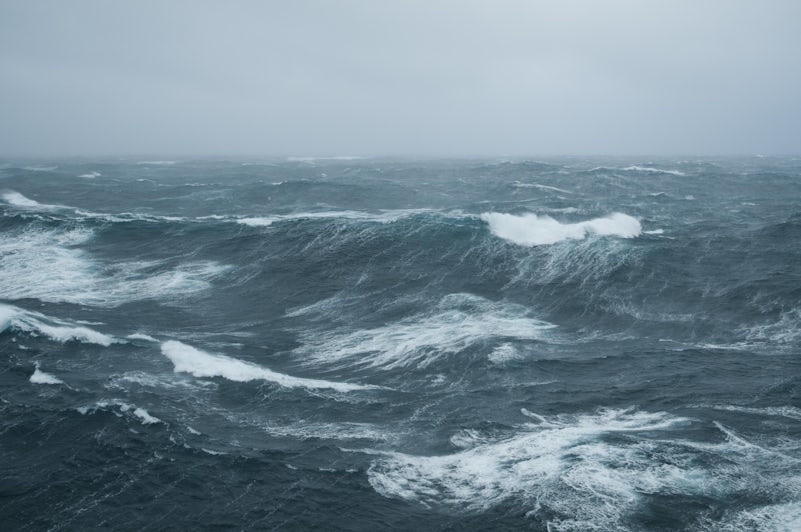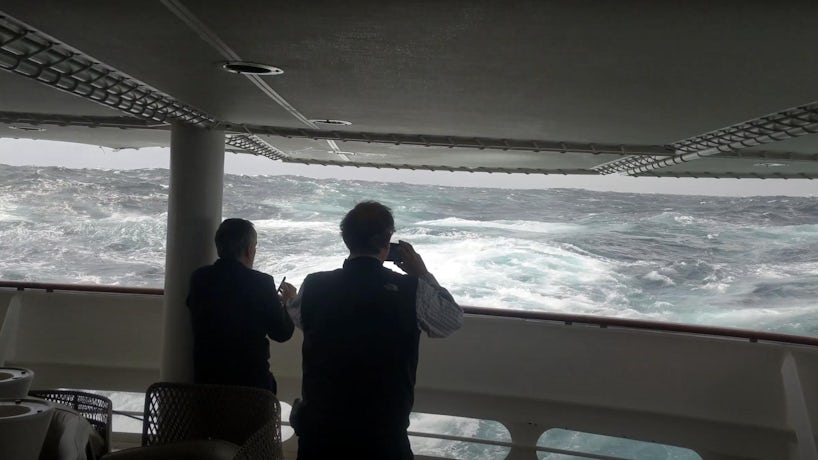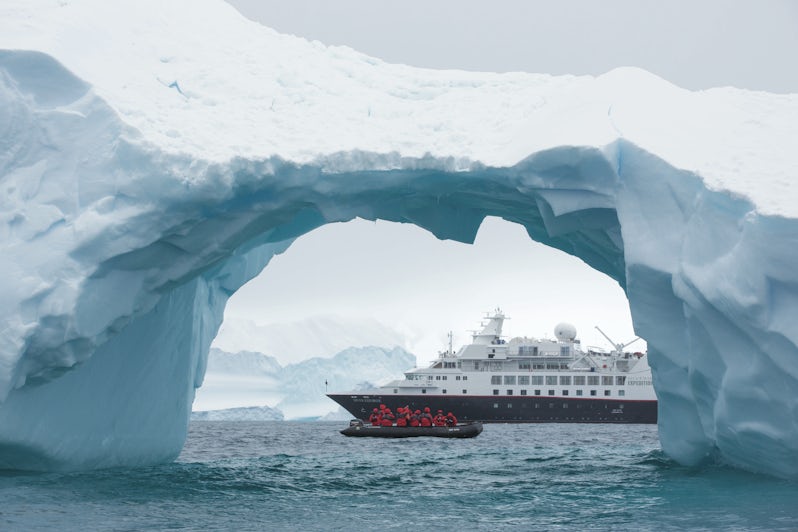
Drake Passage Cheat Sheet: Coping with Seasickness, Antarctica Weather and More


Even the most veteran traveler sees the Drake Passage -- the body of water between South America and Antarctica that you must cross before you set foot at the End of the Earth -- as foreboding. Before my expedition cruise to Antarctica, I found myself reading stories of early explorers to the White Continent and searching for recent accounts of ships sailing through this unpredictable body of water.
For many travelers, crossing the Drake Passage is the deal breaker to make this trip of a lifetime. Forget about the trip's expense and the time it takes to get there –about 48 hours in each direction (or more depending on the weather and the route decided by the captain) -- the Drake Passage can be intimidating.
There are options to fly to the Antarctic Peninsula (which has its own set of challenges), but if you're going to make the bucket list adventure, crossing the Drake Passage is considered a rite of passage and part of the experience of an expedition cruise to Antarctica. I compare my time spent on the Drake Passage to having a baby. You feel miserable at the time, but you soon forget about it after visiting one of the most spectacularly beautiful and magical places on Earth. And then, you’re ready to go again!
With an estimated – and staggering – 100,000 visitors to Antarctica this season – a number that quickly grew from 20,000 tourists in the 1990s to 74,000 visitors in 2019 and 2020, and more ships planned for the foreseeable future, there's an increasing interest in the unpredictable gateway to The Last Continent. With a little sea lore, some history, and a few fun facts, here is our guide to sailing the Drake Passage.
What is the Drake Passage?

The Drake Passage is regarded as one of the world's most dangerous bodies of water to navigate. Though named for the famous 16th-century English explorer Sir Francis Drake during his circumnavigation of the globe between 1577 and 1580, Drake never actually sailed the Drake Passage. Rather, historical records state that Drake inadvertently discovered the waterway when one of his ships drifted near the unknown route in 1578 after passing through the Strait of Magellan, proving there was an open water route below South America.
Spanish marine explorer Francisco de Hoces was also known to have sailed far enough south to see the end of South America in the early 1500s, giving the Spanish name "Mare de Hoces" (Hoces Sea) to the waterway. Since the Spanish considered Drake a pirate because he had an affinity for capturing their treasure-filled ships at sea (and he did), most Spanish literature still refers to the Drake Passage as "Mare de Hoces," named after the Spanish explorer.
However, it was ultimately the Dutch explorer and captain of the Eendracht, Willem Schouten, that is recorded as the first explorer to make the crossing during an expedition in 1616.
Where is the Drake Passage? And Other Drake Passage Facts

The Drake Passage connects the Atlantic and Pacific Oceans at the point where the Atlantic, Pacific, and Southern seas converge. The 600-mile-wide waterway sits between Cape Horn, the southernmost headland of the Tierra del Fuego archipelago in Southern Chile, to 100 miles north of the Antarctic Peninsula at the South Shetland Islands.
The Drake Passage is not a shallow gateway. On the contrary, it's incredibly deep, with an average depth of 11,000 feet, although it can reach depths of more than 15,600 feet at the northern and southern boundaries. The Antarctic Circumpolar Current is also the most voluminous current in the world, with an estimated flow of between 3,400 and 5,300 million cubic feet per second. The current flows primarily from west to east around Antarctica, and at a rate of approximately 600 times the amount of water in the Amazon River.
In addition, there are also no lands around the Drake Passage to break up the flow of water, so the currents at this latitude combined with the strong winds (primarily from the west) and ever-changing weather conditions can produce up to 50-foot-high swells and Beaufort scale 10 – or gale force winds (hurricanes are at Beaufort scale 12) – measuring between 55 to 63 mph or even higher in severe storms. Hurricane Atmospheric low-pressure systems (or cyclones) also come in from the Pacific Ocean and move west to east over the southern edge of the passage. These unpredictable conditions in the Drake Passage are formidable, making the seas challenging to navigate.
It's no wonder that, according to one source, as many as 20,000 sailors have lost their lives to this foreboding body of water – and 800 shipwrecks lie within its depths on the ocean floor.
Drake Passage: Expect the Unexpected

Crossing the Drake Passage is unpredictable; you never know what conditions you will get. As you leave behind civilization and head into one of the most remote places on Earth, it can be a little unsettling not knowing what lies ahead on the Drake Passage. But then again, the intrigue and the uncertainty are also part of the excitement and the journey.
I spoke with several expedition team members on my ship, Atlas Ocean Voyages’ new World Traveller, about their experiences on the Drake Passage. Rodrigo, the resident Ornithologist (bird expert), has made the crossing more than 160 times. He also worked with the first company to bring tourism to Antarctica, Lindblad Expeditions. Another member of the team, Maxi, worked with his father on research ships to Antarctica. He told me one crossing took 18 days from the Antarctic Peninsula to Ushuaia, the port on the southernmost tip of Argentina.
Rodrigo and Maxi have been on old-school vessels and seaworthy ships built specifically for the Drake Passage – and have witnessed all kinds of weather and conditions. They explained how the angle of the wind or waves can make the bow sink and pitch and how certain conditions will cause the captain to change course and shift between systems for a smoother ride.
The Drake Lake on the Drake Passage

The unpredictability of crossing the Drake Passage is that you might get lucky and experience the Drake Lake when it's weirdly calm and almost smooth as glass. If you're fortunate enough to have a smooth crossing, take the opportunity to head outside on the ship's decks for wildlife viewing. This is the perfect opportunity to use your binoculars and pull out the camera to view and capture majestic humpback, orca, or minke whales, and hourglass dolphins on film, or watch the Arctic birds soar overhead, including giant petrels and the world's largest bird measured by wingspan, the Wandering albatross.
The Drake Shake on the Drake Passage

And then again, you may not be so lucky and end up with the Drake Shake, which can have varying degrees of "shake," as mentioned above. You may have mild swells of 12 feet, very little wind, and no oncoming storms to dodge en route to the South Shetland Islands. Then again, you could end up with 40-foot waves in the middle of a rain or snowstorm with gusty winds.
It doesn't take long after departing the mostly calm waters of the Beagle Channel around Ushuaia to know if you're going to be in for a rough ride – or the Drake Shake – while crossing the Drake Passage. The captain, of course, will have updates for the passengers and crew, but no one can prepare you for the tumultuous waves and swells once the ship hits the open ocean.
The worst feeling is knowing that there's nowhere you can go to avoid the rocking, rolling, and constant motion. All you can do is stay calm, keep your mind otherwise occupied, take seasickness precautions (as mentioned below), and settle in for the ride. It will be over in 48 hours or less – at least until the return trip. And always remember – embrace the journey as part of the experience of traveling to Antarctica.
Drake Passage: When to Cross and When Not to Cross the Drake Passage

There's not a definitive time that's better or worse for crossing the Drake Passage. Some sources say the beginning and end of the summer season can have stronger winds and rougher seas, so this would typically be in November and March. I've also read that December and January can be calmer months for the crossing.
Other sources say there's no way to predict the best time to cross the gateway to Antarctica. The best thing to do is to plan the expedition when it’s the right time for you, bring preventative measures (Sea-Bands, medications, ginger gum, etc.), and stay positive as you journey to one of the most magical places on Earth.
Drake Passage: A note on Drake Passage Weather

The Drake Passage is the climatic zone where the weather transitions from the humid and subpolar conditions of Tierra del Fuego to the ice-covered polar regions of Antarctica. Antarctica became isolated after the split from South America, losing the southward flowing currents, and leaving it desolate and frozen.
As you probably know by now, the weather in the Drake Passage is unstable and can quickly change, almost without warning. That's why the captain is constantly monitoring the size of the swells, wind speed, and storms forming further out at sea. It's common practice for a ship to change course or speed to avoid an approaching storm. The volatile mix of factors – the ocean's currents, wind, and temperatures – can have the sun out at one minute and snow falling the next.
In the Antarctic summer -- the opposite of North America -- travelers can typically expect rough seas, clouds, and misty and windy conditions while on the Drake Passage. Average temperatures range from 26 degrees Fahrenheit in the south to 41 degrees Fahrenheit in the north. If you want to check out the current weather in the Drake Passage, this site, PassageWeather.com, is one of the resources captains use to forecast the conditions for the ship's crossing and adjust their course accordingly.
How to Fend Off Seasickness on Rough Drake Passage Waves

Even if you're not prone to seasickness, you should take a few preventative measures for crossing the Drake Passage. It's possible that you could have the Drake Lake at one moment and the Drake Shake an hour later, so it's best to come prepared for your crossing. It's also helpful to take the advice of crew members who sail this route almost every week from late October or early November until March.
Sea-Bands. The minute the captain announced that we were headed for the Drake Passage the evening we sailed from Ushuaia, I headed to my stateroom to put on my Sea-Bands: two elastic wristbands that use acupuncture pressure points to ward off seasickness. While I wasn't totally buying into the concept that two small balls pressing on the underside of my wrist would prevent nausea on seas as rough as the Drake Passage, I noticed the expedition leader and some of the crew with the bands. So, maybe there was something to this little stretchy band after all. And it's a natural method to control nausea.
Dramamine, Bonine or Scopolamine Patches. Medications like Dramamine, Bonine and the Scopolamine transdermal patches (that sit behind your ear) are also effective in reducing motion sickness and seasickness. The patches typically last several days, but you need to apply them about four hours before you set sail. The downside is that both medications have side effects like drowsiness. Of course, that may not be the worst thing if you're feeling the effects from the motion. Sleep cures almost everything. You should also know that the patches can cause blurred vision or dry mouth and dry nose, so you must decide if the benefits outweigh the side effects.
Stay Calm and Get Fresh Air. One way to keep seasickness at bay is to stay calm, which is where a good diversion comes in, like an onboard lecture about explorer Ernest Shackelton or a movie about penguins. It's also a good idea to step outside and take in the fresh air, even if it's just for a moment. I took a quick walk around the back deck before lunch and perked right up. Some people also suggest staring at the horizon, but others advise not to look outside, so that's a personal call.
Have a Light Meal and Stay Hydrated. The crew also recommends keeping something on your stomach, such as a light breakfast or lunch – and staying hydrated. Think toast and hot tea or ginger ale if nothing else appeals. It's best to avoid heavy, fatty, or spicy foods unless your gut is OK, then go for it. The ship will have options for all types of light bites during the sea days. You can also try ginger candies, gum, tea, or even foods made with ginger to settle your tummy. It's also best to avoid alcoholic beverages.
Stay in the Middle of the Ship. Head to the middle of the ship. This is where you'll feel the least amount of motion. I camped out on Deck 4 of our expedition ship, where the public spaces are located. This felt like the most stable area of the ship. My stateroom was on Deck 6, where I could feel more of the motion. If you're in the public areas, you'll also stay busy chatting with other passengers and crew, keeping your mind off the rocking and rolling seas.
Visit the Ship's Doctor .If all else fails (and you're really motion sick), you can visit the ship's doctor, get a shot of Dimenhydrinate, and sleep away the rest of the day. For some people, staying in bed, resting, and watching the ship's lectures and programming on television may be the best option. I found that even without any medication, the ship's motion lulled me to sleep. Sleeping also passes the time and gets you closer to Antarctica – or back to the Beagle Channel on the return trip, where the waters will be much calmer.
If I can survive the Drake Passage, you can, too.